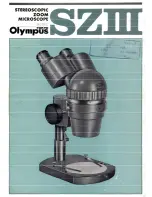
Complete Teardown, Cleaning, and Reassembly of the Olympus BH2-6RE Modular Revolving Nosepiece
Page 15 of 18
Revision 3
outer perimeter of the revolving turret, spaced
approximately 180° apart (see
Figure 42
–
Apply black adhesive to the revolving turret
Carefully reinstall the knurled-rubber grip ring onto the
outer perimeter of the revolving turret, making sure to
not stretch or damage the grip ring (see
Figure 43
–
Reinstall the knurled-rubber grip ring
Use dry cotton swabs to thoroughly remove any visible
silicone RTV squeeze-out (see
Figure 44
–
Remove any silicone RTV squeeze-out
Ready for Service
The newly reconditioned BH2-6RE modular revolving
nosepiece assembly is now ready to provide many more
years of service (see
).
Figure 45
–
BH2-6RE ready to be put back into service
Requirements for Periodic Maintenance
Periodic cleaning and application of fresh grease to the
mechanical detent notches in the stationary base is
necessary to minimize wear of the mechanical detents,
thereby maximizing the useful service life of the
BH2-6RE. This can be easily accomplished by simply
removing the protective cover, cleaning and re-greasing
the detent notches, and then reinstalling the protective
cover per the procedures detailed in this document.
The dovetail slide does not need to be removed to
perform this periodic maintenance. If the equipment
sees heavy usage, this service should be performed on a
six-month interval
3
.
Problems with the Turret Assembly
A few problems with the turret assembly can
sometimes be found in the reassembled nosepiece. The
first will be seen if one or more of the mechanical
detents are excessively worn. This will cause radial float
of the revolving turret in one or more of the objective
positions, and these objectives will have trouble
returning to and maintaining their proper index
position. This can make it difficult to utilize some
illumination types, such as phase contrast, since the
phase annuli will not be able to hold an acceptable
alignment due to variations in objective indexing.
The other problem that may be seen is caused by
overall float of the revolving turret, relative to the
center point of the stationary base. If there is excess
3
Field experience has shown that even heavily used scopes (such as those
used in hospitals and clinical lab settings), when lubricated on a six-month
interval, can be expected to provide many years of trouble-free service.


































